3-Ingredients Homemade Fresh Fettuccine Pasta Recipe (Without The Machine!)

Fettuccine is a type of homemade fresh pasta typical of the northern and central regions, ideal for bringing to the table for a Sunday family lunch or a convivial dinner with guests. Similar to tagliatelle from Emilia , they differ from the latter only in the width of the pasta strips cut, which are slightly thinner.
As the name suggests, they are prepared by slicing with a knife, or reducing into strips of about 1/2 cm wide, the fresh egg pasta, expertly stretched with a rolling pin into a sheet of a few mm thick and then rolled up on itself to form a cylinder. Once ready, you just need to delicately open the fettuccine, arrange them in a nest on a floured cutting board and then choose whether to let them air dry or immediately plunge them into boiling salted water, ready to receive the most varied condiments.
What is Homemade Fettuccine?
Fettuccine, a traditional Italian pasta, originates from central and northern Italy, particularly Lazio and Tuscany. It consists of egg and flour, hand-cut into ribbon-like strips. Regional variations include the famous Roman Fettuccine Alfredo, a creamy dish beloved in America, while Fettuccine alla Papalina offers a richer, meat-based sauce. Fun fact: Fettuccine's name comes from "fettucce," meaning "ribbons," reflecting its flat, broad shape. This versatile pasta can be paired with a wide variety of sauces, from simple tomato to luxurious truffle cream.
Pro Tips for The Best Homemade Fettuccine
- Use high-quality, fresh eggs and fine flour for a smooth, tender dough.
- Knead the dough until elastic and smooth, letting it rest before rolling.
- Roll the dough thinly and cut evenly for uniform cooking.
- Cook fettuccine in well-salted, boiling water for a few minutes until al dente.
- Toss the cooked fettuccine directly with your chosen sauce to help it absorb flavors.
What is The Best Flour to Use for Fettuccine Pasta?
The best type of flour to use for fettuccine pasta is 00 flour, which is finely milled and perfect for making soft, smooth pasta. You can also mix it with semolina flour for added texture and firmness, which helps the pasta hold its shape better.
Can I Flavor the Dough With Something?
Yes, you can flavor fettuccine dough with ingredients like spinach, beetroot, or saffron for added color and taste. You can also use herbs like basil or parsley, or even spices such as black pepper or chili powder, to infuse the dough with extra flavor.
Can I Use a Machine to Work The Dough?
Of course! After kneading and resting the dough, roll it through the machine several times, gradually thinning it out to your desired thickness. Then, use the machine's cutting attachment to create uniform fettuccine strips. This method ensures even, consistent results and saves time compared to hand-rolling.
Why is My Homemade Pasta so Dry?
Pasta can turn out dry if there's not enough moisture in the dough, which can happen if you use too much flour or don't add enough eggs. Over-kneading or not letting the dough rest properly can also cause it to become dry. Additionally, undercooking the pasta or not using enough sauce can lead to dryness after cooking.
How Can I Use These Fettuccine Pasta?
You can use homemade fettuccine in a variety of ways, such as pairing it with classic sauces like Alfredo, Bolognese, or simple butter and sage. It also works well with seafood, vegetable-based sauces, or rich cream-based options. For a lighter meal, toss it with olive oil, garlic, and fresh herbs. Homemade fettuccine absorbs sauces well.
How Long Should I Cook Fresh Homemade Fettuccine?
Homemade fettuccine typically cooks in 2-3 minutes in boiling salted water. It’s important to watch closely, as fresh pasta cooks much faster than dried pasta. Once the fettuccine floats to the top and has a firm but tender bite (al dente), it’s ready to be drained and served.
Can I Make These Fettuccine Pasta Ahead of Time?
Yes! After cutting the pasta, dust it with flour to prevent sticking and store it in an airtight container in the refrigerator for up to 2 days.
Do The Homemade Fettuccine Freeze Well?
Luckily, they do! After cutting, dust the pasta with flour, form it into small nests, and freeze them on a tray. Once frozen, transfer the nests to a freezer bag. When you're ready to cook, you can add the frozen fettuccine directly into boiling water without thawing. This allows you to enjoy fresh-tasting pasta anytime.
How to Store Homemade Fettuccine Pasta
Fettuccine can be stored in the fridge, in an airtight container or covered with cling film, for up to 4 days. Alternatively, you can let them dry thoroughly and store them in a paper bag, at room temperature, for about 1 month.
Ingredients
How to Make Homemade Fettuccine Pasta
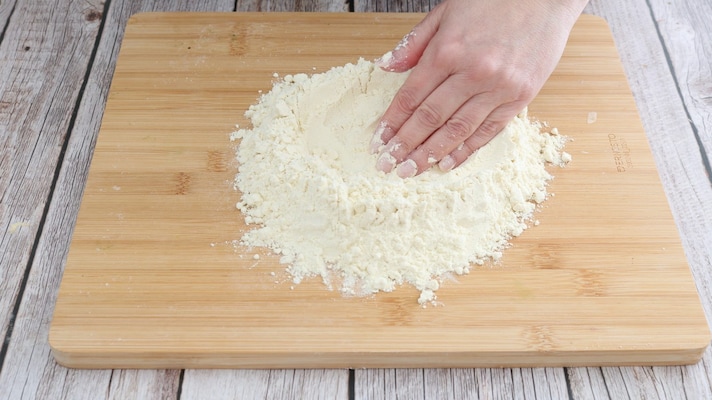
Arrange the flour in a fountain shape.
Arrange the flour in a fountain shape.
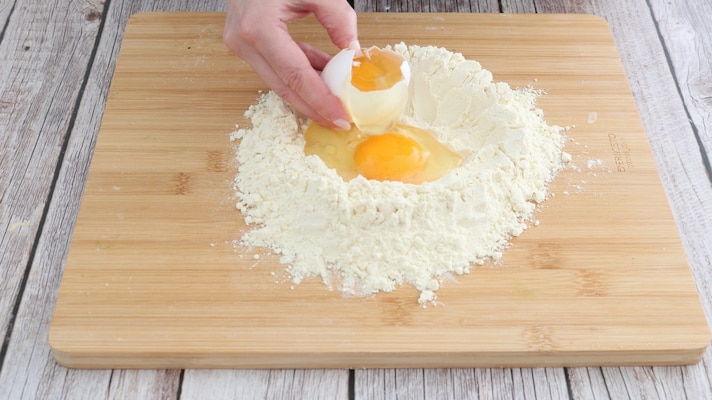
Break the eggs in the center.
Break the eggs in the center.
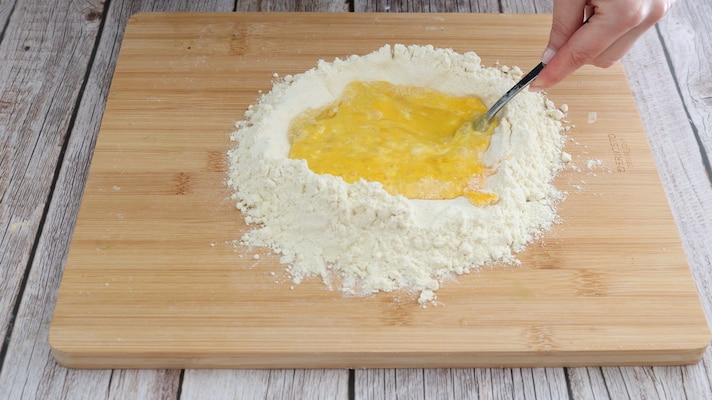
Add a pinch of salt and beat the eggs with the prongs of a fork.
Add a pinch of salt and beat the eggs with the prongs of a fork.
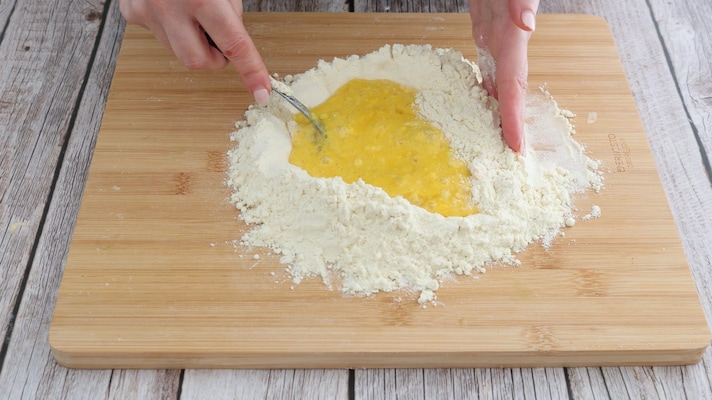
Gradually incorporate the flour.
Gradually incorporate the flour.
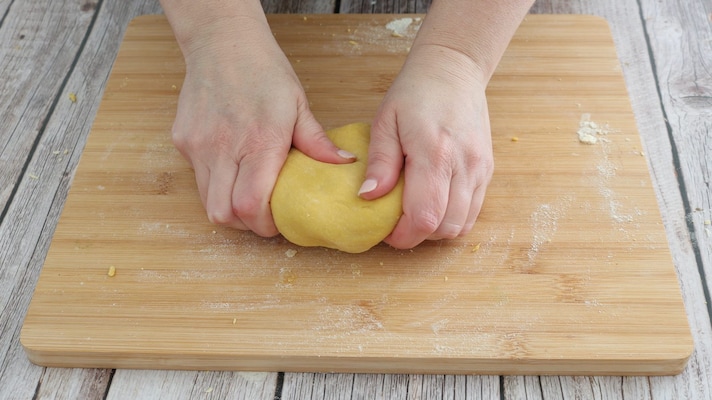
Continue kneading with your hands for about 15 minutes, or until you obtain a smooth and homogeneous dough; then wrap it in a sheet of cling film and let it rest at room temperature for half an hour.
Continue kneading with your hands for about 15 minutes, or until you obtain a smooth and homogeneous dough; then wrap it in a sheet of cling film and let it rest at room temperature for half an hour.
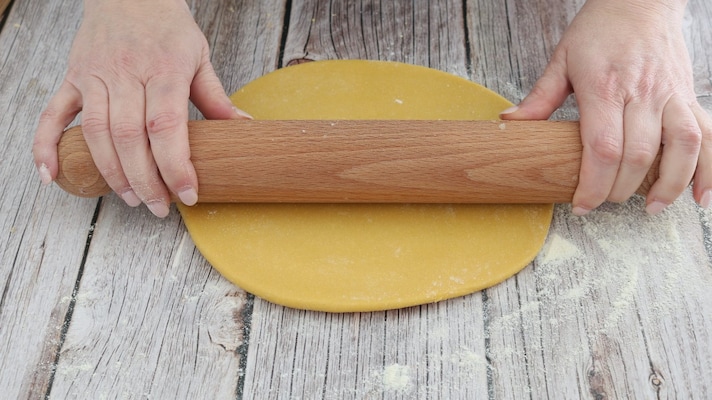
Once the resting time has elapsed, roll out the pasta dough with a rolling pin on a floured working surface.
Once the resting time has elapsed, roll out the pasta dough with a rolling pin on a floured working surface.
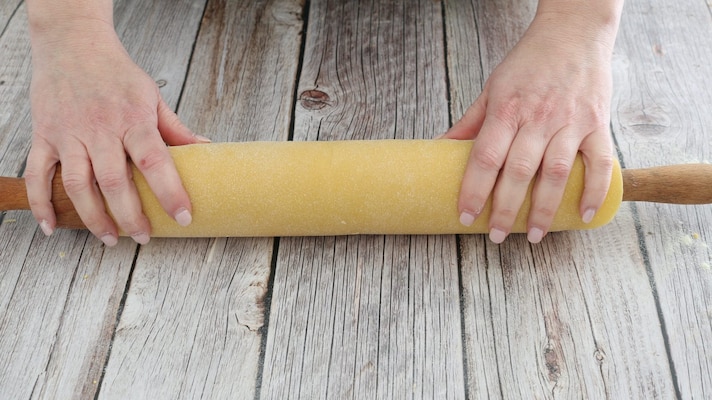
To make the dough thin, wrap the pastry around the rolling pin and continue to roll out, pulling the dough slightly.
To make the dough thin, wrap the pastry around the rolling pin and continue to roll out, pulling the dough slightly.
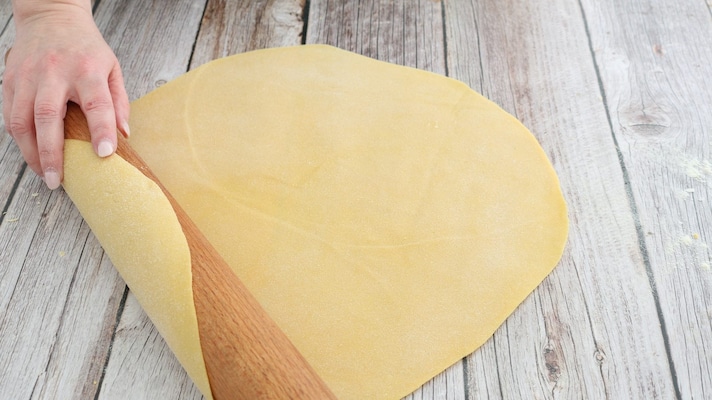
Then unroll the dough and repeat the operation.
Then unroll the dough and repeat the operation.
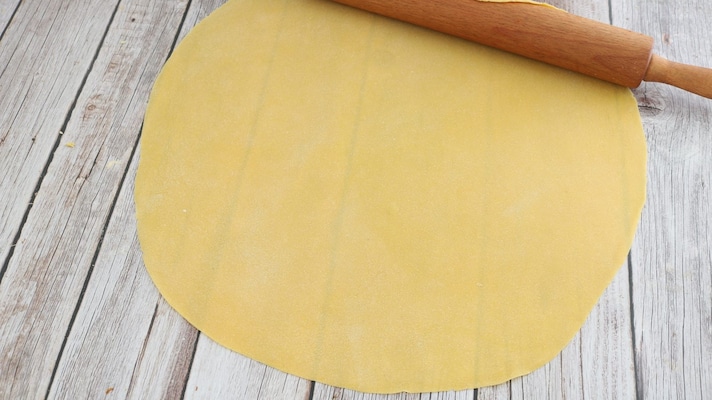
At the end you should obtain a thin sheet of dough of about 2-3mm thickness.
At the end you should obtain a thin sheet of dough of about 2-3mm thickness.
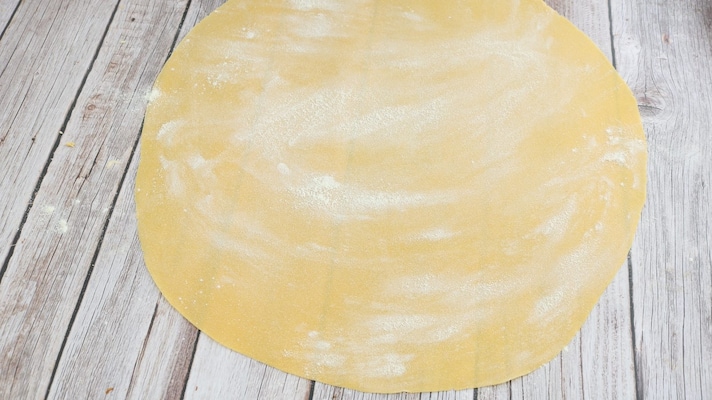
At this point, sprinkle the pasta dough with a little flour.
At this point, sprinkle the pasta dough with a little flour.
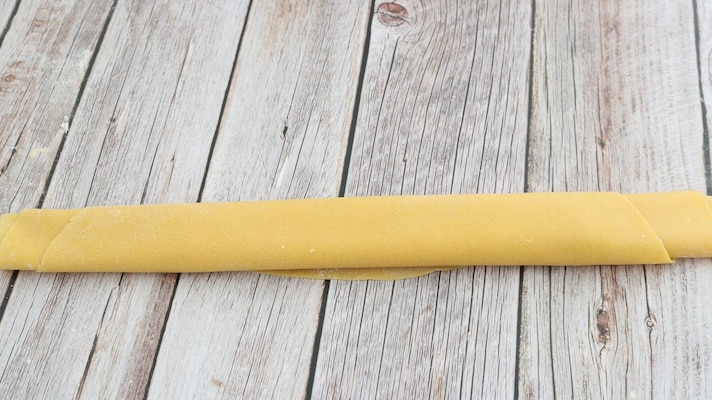
Roll the fresh pasta dough on itself until you obtain a cylinder of pasta.
Roll the fresh pasta dough on itself until you obtain a cylinder of pasta.
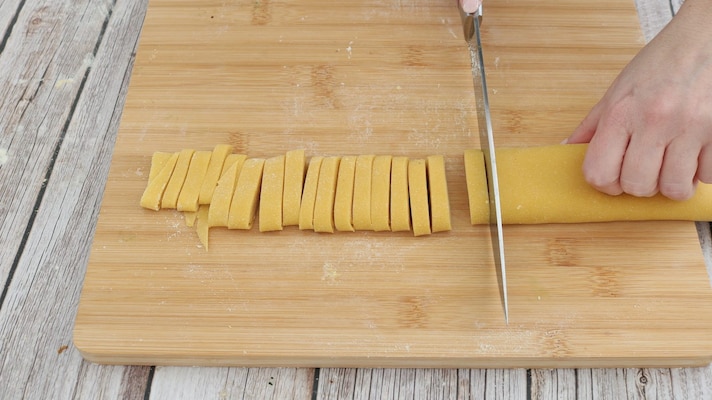
Using a sharp knife, cut the roll into slices about 5mm wide.
Using a sharp knife, cut the roll into slices about 5mm wide.
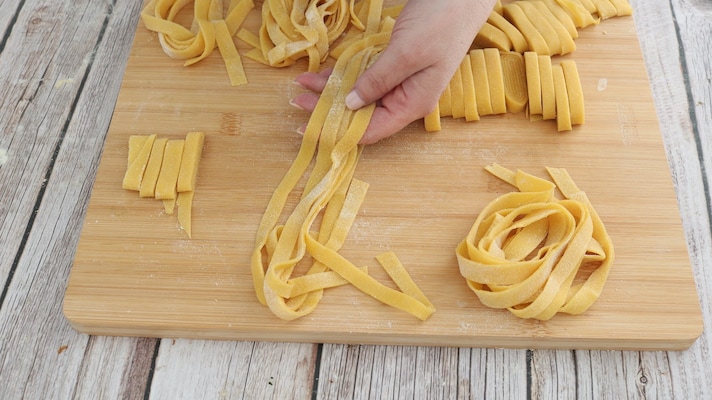
Gently open the strips of pasta obtained and arrange them in a nest on a pastry board.
Gently open the strips of pasta obtained and arrange them in a nest on a pastry board.
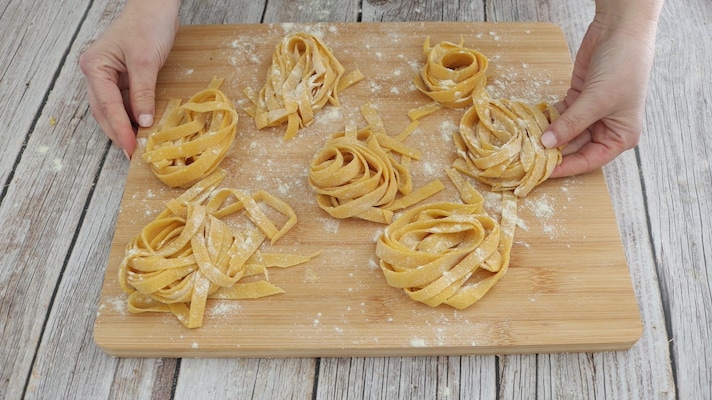
Sprinkle the pasta nests with flour.
Sprinkle the pasta nests with flour.

Your homemade fettuccine pasta are ready to be cooked in boiling salted water for about 2-3 minutes, and then seasoned to your taste with your favorite sauces. Enjoy!
Your homemade fettuccine pasta are ready to be cooked in boiling salted water for about 2-3 minutes, and then seasoned to your taste with your favorite sauces. Enjoy!
;Resize,width=767;)


